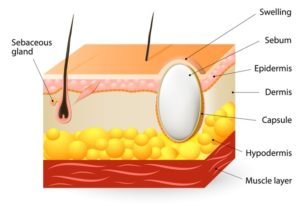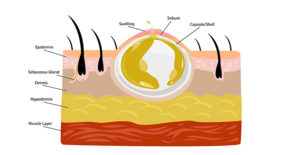Epidermoid cysts are noncancerous small bumps beneath the skin. They can appear anywhere on the skin, but are most common on the face, neck and trunk.
Epidermoid cysts are slow growing and often painless, so they rarely cause problems or need treatment. You might choose to have a cyst removed by a doctor if its appearance bothers you or if it’s painful, ruptured or infected.
Many people refer to epidermoid cysts as sebaceous cysts, but they’re different. True sebaceous cysts are less common. They arise from the glands that secrete oily matter that lubricates hair and skin (sebaceous glands).
Symptoms
Epidermoid cyst signs and symptoms include:
- A small, round bump under the skin, usually on the face, neck or trunk
- A tiny blackhead plugging the central opening of the cyst
- A thick, yellow, smelly material that sometimes drains from the cyst
- Redness, swelling and tenderness in the area, if inflamed or infected
Causes
The surface of your skin (epidermis) is made up of a thin, protective layer of cells that your body continuously sheds. Most epidermoid cysts form when these cells move deeper into your skin and multiply rather than slough off. Sometimes the cysts form due to irritation or injury of the skin or the most superficial portion of a hair follicle.
The epidermal cells form the walls of the cyst and then secrete the protein keratin into the interior. The keratin is the thick, yellow substance that sometimes drains from the cyst. This abnormal growth of cells may be due to a damaged hair follicle or oil gland in your skin.
Many people refer to epidermoid cysts as sebaceous cysts, but they’re different. True sebaceous cysts are less common. They arise from the glands that secrete oily matter that lubricates hair and skin (sebaceous glands).
Risk factors
Nearly anyone can develop one or more epidermoid cysts, but these factors make you more susceptible:
- Being past puberty
- Having certain rare genetic disorders
- Injuring the skin
Complications
Potential complications of epidermoid cysts include:
- An epidermoid cyst can become tender and swollen, even if it’s not infected. An inflamed cyst is difficult to remove. Your doctor is likely to postpone removing it until the inflammation subsides.
- A ruptured cyst often leads to a boil-like infection that requires prompt treatment.
- Cysts can become infected and painful (abscessed).
- Skin cancer.In very rare cases, epidermoid cysts can lead to skin cancer.
Treatment
You can usually leave a cyst alone if it doesn’t cause discomfort or cosmetic problems. If you seek treatment, talk with your doctor about these options:
- This treatment involves injecting the cyst with a medicine that reduces swelling and inflammation.
- Incision and drainage.With this method, your doctor makes a small cut in the cyst and gently squeezes out the contents. This is a fairly quick and easy method, but cysts often recur after this treatment.
- Minor surgery.Your doctor can remove the entire cyst. You may need to return to the doctor’s office to have stitches removed. Minor surgery is safe and effective and usually prevents cysts from recurring. If your cyst is inflamed, your doctor may delay the surgery.

 099006 19622
099006 19622





 Join Us On Facebook
Join Us On Facebook Join Us On Twitter
Join Us On Twitter Join Us On In.com
Join Us On In.com Subscribe to Our Blog
Subscribe to Our Blog